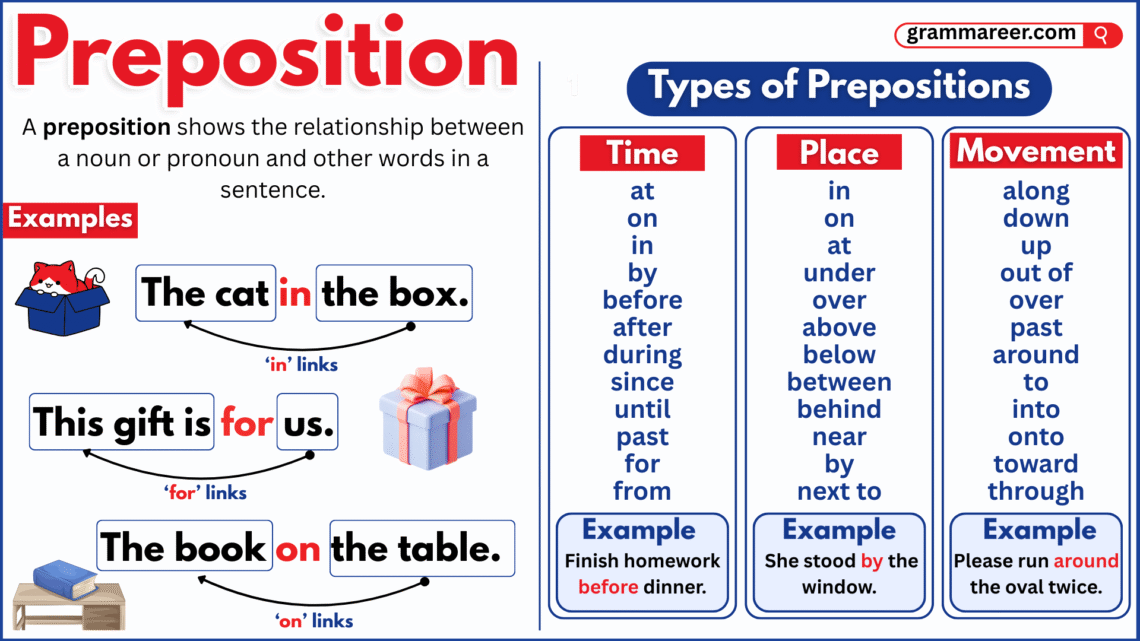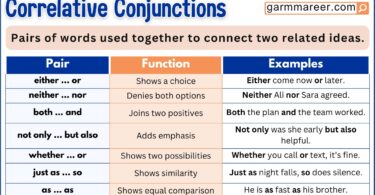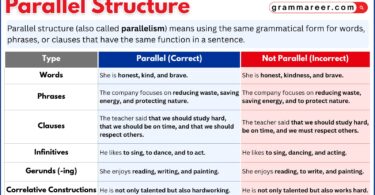Prepositions are little words we use all the time without even noticing. They help link one part of a sentence to another so that our meaning is clear. For example, we say the keys are on the table or I’ll meet you at 5 o’clock. Words like on and at are prepositions.
In this article, we’ll look at what prepositions are, how they work, and some common examples you can start using with confidence.
Table of Contents
What are Prepositions?
A preposition is a small word that shows the relationship between two things in a sentence. Think of it as a bridge that connects words together so the meaning is clear.
For example:
- The book is on the table. (shows place)
- We met at 7 o’clock. (shows time)
- She walked through the park. (shows direction)
Prepositions are usually short words like in, on, at, by, with, to, and from. They always come before a noun or pronoun. The tricky part is that sometimes you can’t just swap one preposition for another. For example, interested in is correct, but interested on is not. That’s why it’s important to learn how they’re used.
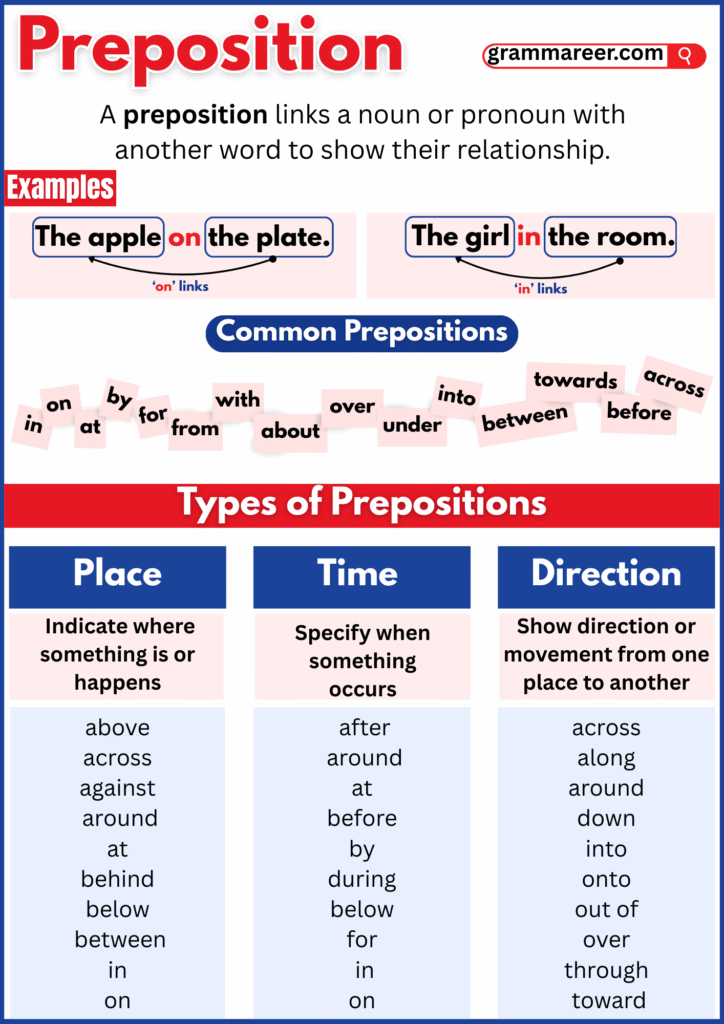
How to Use Prepositions Correctly?
Prepositions may be small, but they carry a lot of meaning in a sentence. They help us explain where, when, how, and why something happens.
Here are some examples:
- Place: The keys are on the table.
- Time: We’ll meet after lunch.
- Direction: She walked into the room.
- Cause/Reason: He succeeded because of hard work.
Sometimes, the same preposition can mean different things depending on the sentence.
- She stood by the window. (place)
- The decision was made by the manager. (who did it)
That’s why prepositions can feel tricky—they change their role depending on the context.
Also, changing just one preposition can change the meaning of a sentence:
- He is interested in music. (he likes music)
- He is interested on music. (❌ incorrect and confusing)
Easy Rules for Using Prepositions
These simple rules can help you a lot in using prepositions correctly and make your sentences sound more natural.
1. Don’t put prepositions right after helping verbs.
You can’t drop them in the middle of verb phrases.
- ❌ I have in finished my homework.
- ✅ I have finished my homework.
2. Prepositions usually stay close to what they describe.
Keep them next to the word they belong with.
- ❌ With him I went to the party.
- ✅ I went to the party with him.
3. Changing the preposition changes the meaning.
Be careful—one small switch can tell a different story.
- The dog ran to the yard. (shows direction)
- The dog ran in the yard. (shows location)
The good thing is, you don’t have to memorize every rule. With practice and examples, prepositions start to make sense naturally and don’t worry ahead, we’ll go through the list and types of prepositions to clear up all the confusion.
Types of Prepositions
Once you understand these types of prepositions, a lot of the confusion you usually feel will start to make sense. Let’s start it:
Prepositions of Place
These prepositions tell us where something or someone is. Think of them as little signposts that point to a location.
Examples:
- On → The book is on the table.
- At → She’s waiting at the bus stop.
- Under → The shoes are under the bed.
- Above → The plane is flying above the clouds.
- Between → The park is between the school and the library.
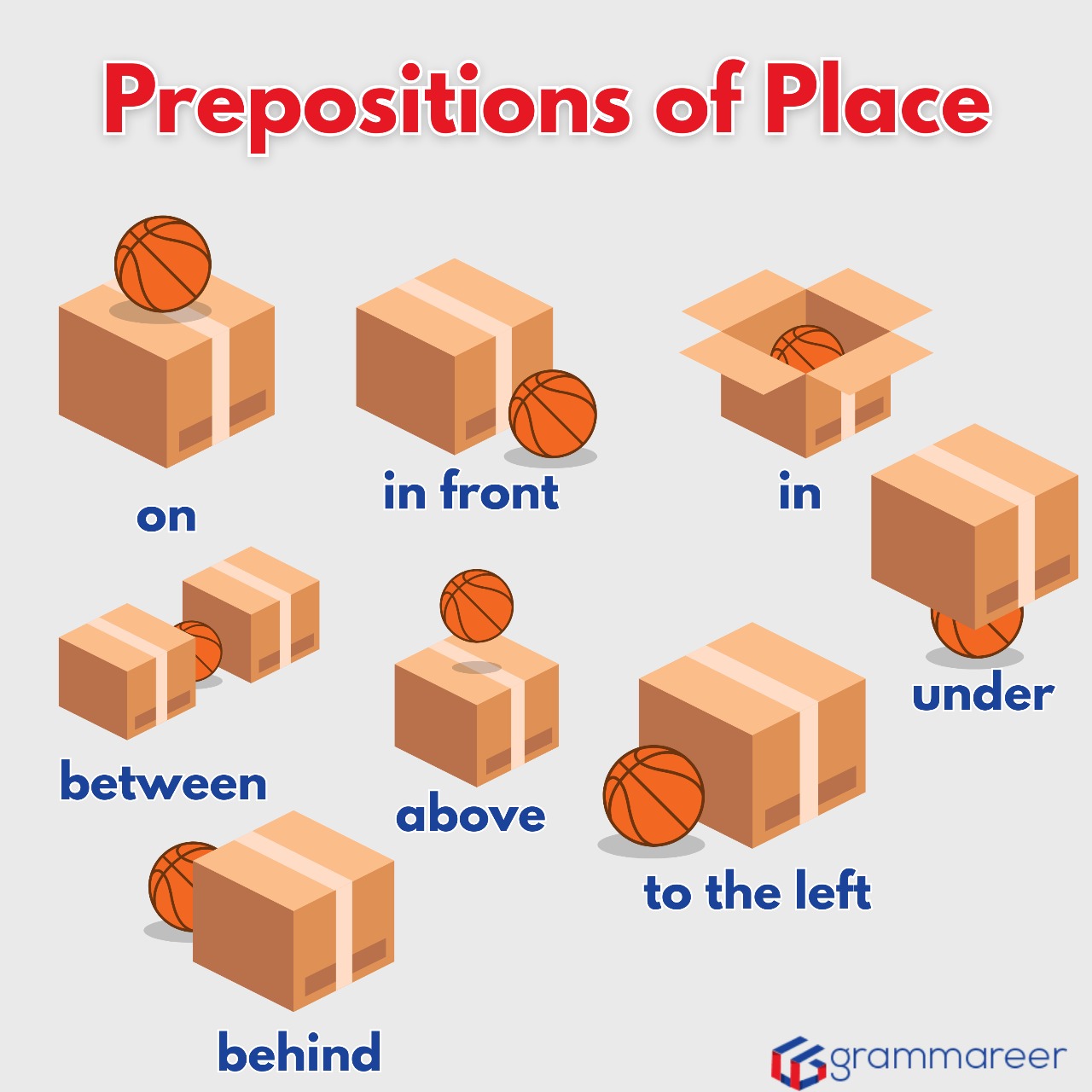
Prepositions of Time
These show when something happens. They’re like clocks in language.
Examples:
- In → We met in January.
- On → The party is on Friday.
- At → I’ll call you at 8 PM.
- Since → He’s been here since morning.
- For → She studied for two hours.
- During → We stayed inside during the storm.
- After → Let’s eat after the movie.
Prepositions of Direction or Movement
These describe where someone or something is going.
Examples:
- To → She walked to the park.
- Onto → The cat jumped onto the sofa.
- From → They came from Italy.
- Through → He ran through the tunnel.
- Along → We drove along the river.
- Towards → The boy moved towards the door.
Prepositions of Manner, Cause, and Purpose
These explain how, why, or for what reason something happens.
Examples:
- With → She solved the puzzle with ease.
- Through → He succeeded through hard work.
- Because of → The flight was delayed because of the weather.
- For → This gift is for you.
- Out of → She cried out of happiness.
Prepositions of Possession
These show who something belongs to.
Examples:
- Of → The cover of the book.
- With → A man with a hat.
- To → The key to the house.
- By → A play by Shakespeare.
Prepositions of Comparison and Contrast
These highlight similarities or differences.
Examples:
- Like → She sings like a professional.
- Unlike → Unlike his brother, he is shy.
- Than → He is taller than me.
- Similar to → This phone is similar to mine.
- In contrast to → In contrast to last year, sales have dropped.
Object of a Preposition
Whenever you see a preposition, it’s always pointing to something — that “something” is called the object of the preposition. Think of it like this: a preposition never stands alone; it always needs a partner (a noun or pronoun) right after it to make sense.
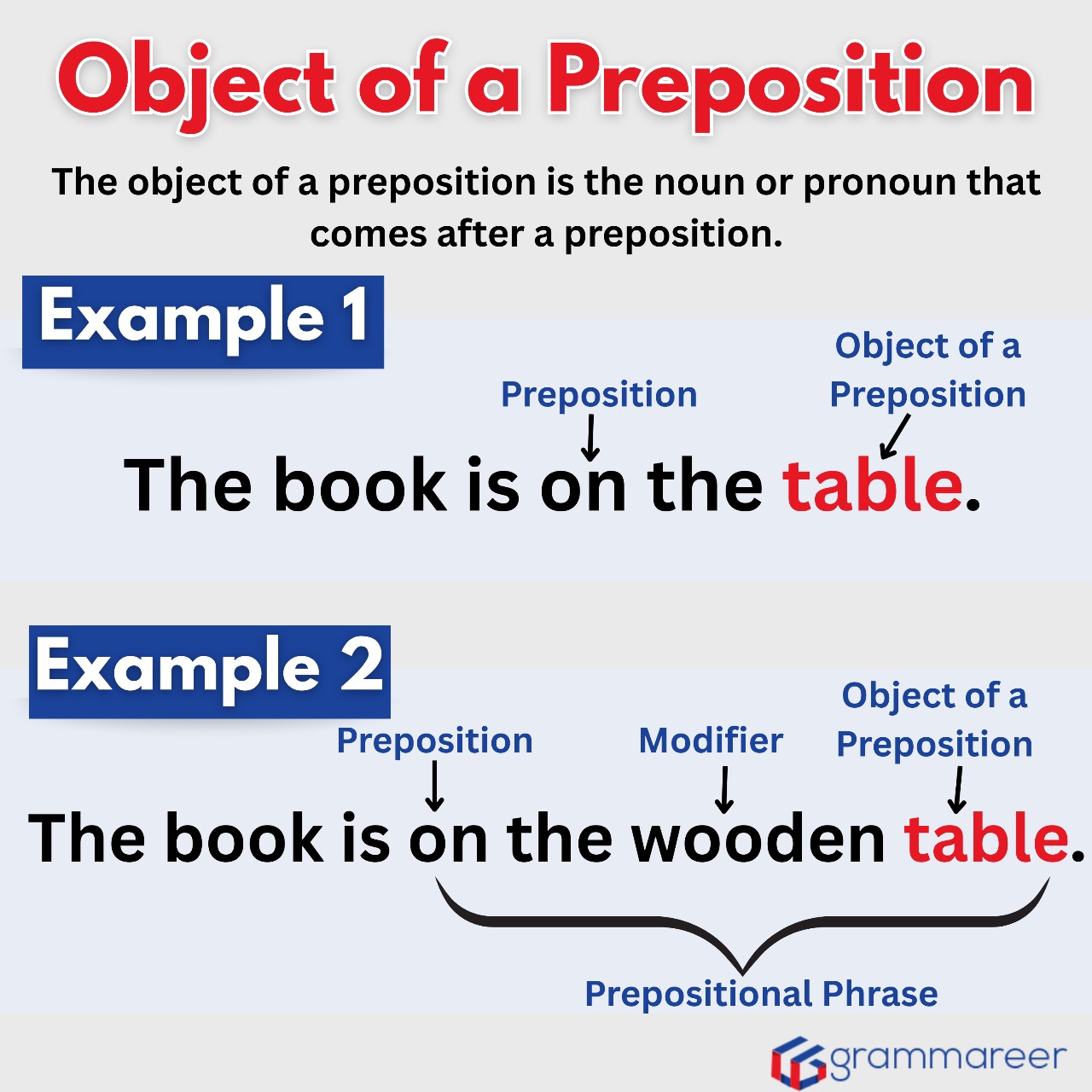
Prepositional Phrases
A prepositional phrase is a small group of words that starts with a preposition and ends with a noun or pronoun (called the object). These phrases usually add extra details, like showing where, when, or how something happens.
Examples:
- She is sitting on the chair.
- (preposition: on, object: chair)
- We will meet at the park.
- (preposition: at, object: park)
- The cat is hiding under the table.
- (preposition: under, object: table)
- They arrived after the party.
- (preposition: after, object: party)
Commonly Used Prepositions List
Prepositions are everywhere in English. To make them easier to learn, here’s a handy list of the ones you’ll come across most often in everyday conversations, reading, or writing.
| On | At | In | Over |
| Around | Through | Opposite | In front of |
| Behind | Beneath | Beside | Above |
| Below | Under | Underneath | Down |
| Up | Out | With | Into |
| Onto | Across | After | Before |
| Near | Among | Along | Between |
| Toward | Away from | From | To |
| Next to | By | Untill | About |
Common Preposition Mistakes (and How to Fix Them)
Prepositions can be confusing, especially because one small change can totally flip the meaning of a sentence. Don’t worry—here are some everyday mistakes learners often make and how to correct them in a clear way.
Mixing Up in and at (Place)
People often get stuck choosing between in and at when talking about places.
| Incorrect | Correct | Why |
| I’m at the car. | I’m in the car. | Use in when you’re inside something. |
| She is in the bus stop. | She is at the bus stop. | Use at for specific points/locations. |
Confusing since and from
These two are used for time but in different ways.
| Incorrect | Correct | Why |
| I have been here from 2010. | I have been here since 2010. | Use since with a starting point in time. |
| He worked here since two years. | He worked here for two years. | Use for with a length of time. |
Wrong Use of to and at
Sometimes learners mix these up when talking about direction or arrival.
| Incorrect | Correct | Why |
| She arrived to the office late. | She arrived at the office late. | Use at with places of arrival. |
| We reached at the station early. | We reached the station early. | No preposition is needed after reached. |
Mixing Up on and over
Both can talk about position, but they’re not always the same.
| Incorrect | Correct | Why |
| The picture is over the wall. | The picture is on the wall. | Use on when something touches a surface. |
| The plane flew on the city. | The plane flew over the city. | Use over when something is above and moving. |
Extra Prepositions (Not Needed!)
Sometimes we throw in extra words when they don’t belong.
| Incorrect | Correct | Why |
| Where are you at? | Where are you? | At is unnecessary here. |
| She discussed about the problem. | She discussed the problem. | About is not needed. |
| Let’s go together with. | Let’s go together. | With is extra. |
Mixing Up beside and besides
These two look alike but mean different things.
| Incorrect | Correct | Why |
| He sat besides me. | He sat beside me. | Beside means “next to.” |
| I don’t like coffee beside tea. | I don’t like coffee besides tea. | Besides means “in addition to.” |
Summary
Prepositions may be small words, but they do a big job in English. They help us talk about time, place, direction, and relationships between different parts of a sentence.
When you put them together with a noun or pronoun, you get prepositional phrases, which add extra detail and make your sentences clearer.
The key is to practice and notice how native speakers use them. Over time, choosing the right preposition will feel more natural, and you won’t have to stop and think so much.
Keep practicing, keep paying attention, and soon prepositions will become a smooth part of your English conversations.
You May Also Like

